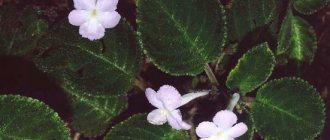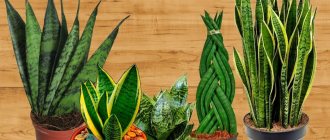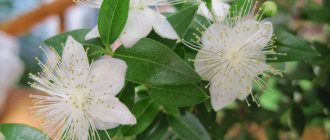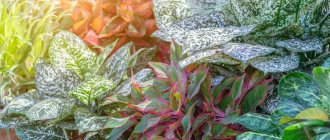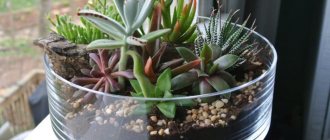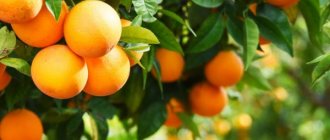Heliconia is recognized as a prominent representative of the tropics, which can be grown at home. This curiosity of the plant world does not often end up in the collection of flower growers, but the fabulous appearance of the flower makes even beginners pay attention to it.
Related posts Hemanthus Zebrina Aeschynanthus Brachychiton
With bright light and sufficient humidity, the crop can bloom all year round with multi-tiered scarlet ears. No less decorative are the wide leaves of the plant, similar to those of bananas.
Botanical description
According to Greek mythology, the name of the genus is associated with Mount Helikon, where charming muses lived near sacred springs. Until the beginning of the twentieth century, Heliconia was part of the Banana family. But the similarity was only external. Further, at the insistence of the Japanese scientist Nakai, the culture was allocated in 2003 to a separate family of Heliconiaceae, which is included in the order Zingiberaceae.
In its natural environment, it is distributed in the tropical forests of Central and South America with a humid climate, where it grows on mountain slopes, in forests, on the sea coast, near rivers - that is, in all damp places with good drainage. The genus includes about 2,500 species of Heliconia, but only about 200 species have been described in detail by botanists.
Heliconia is a rhizomatous herbaceous perennial and develops from the underground part. Some species are cultivated for home cultivation due to the variegated color of the inflorescences and the different sizes and shapes of the leaves, similar to those of a banana, but unlike it, the arrangement of the leaf blades is double-rowed.
The location of the rhizome is horizontal, from which a pseudostem with many vaginal leaves grows. The plant can reach a height of 3 to 6 or more meters and about 1-2 meters in width.
A characteristic feature of the culture is the bright inflorescence, which is mostly formed on the terminal part of the erect shoot. And only some varieties form inflorescences in basal shoots without leaves. They can remain on the bush for several days and even months, then die off along with the shoot. The crop blooms the next year after planting.
Local residents compare the bizarre shape of the leaves to a crab claw, and the brightly colored bracts in yellow-orange, pink and scarlet tones to a parrot's beak. Hence the name of the flower - parrot. The border on the edges of the bracts in a yellow or green hue gives greater expressiveness to the inflorescences with a glossy shine and elasticity due to a waxy coating.
Due to the similarity of the plant with Strelitzia, Heliconia is called false bird of paradise or false Strelitzia. In some species, the structure of the inflorescences is strikingly similar to an intricately shaped shoe. The flowers themselves are inconspicuous and seem to be aware of this shortcoming, hiding under the covering leaves. After flowering is completed, deep blue seed fruits are formed.
The desire to grow heliconia at home does not always coincide with the owners’ space capabilities. It should be taken into account that heliconia has considerable dimensions for growing indoors, from 0.6 to 3 meters in height and 0.5-2.0 meters in width.
Secrets of success
In order to ensure mass flowering, it is recommended to place an exotic representative of the Gesneriev family in eastern or western exposure. The northern side of the room is unfavorable for the start of budding, and sunburn on the leaf blades cannot be avoided on the southern windowsill.
In early spring, it is recommended to add additional light to the plant, since for active vegetation it needs a long daylight hours (12–14 hours). Eucodonia is quite thermophilic, so normal room temperature, within +20–24°C, will suit it best.
Since the leaves of this specimen are densely pubescent, water should not fall on them when watering. To moisten the soil, use only settled water at room temperature. It is recommended to water in the tray or on the edge of the pot as needed: this is indicated by the dryness of the top layer of the substrate in the pot. But it is also impossible to bring the plant so that the soil is separated from the edges of the flower container.
Since Eucodonia is a representative of the humid tropics, it needs to be provided with high humidity. This can be done not by spraying the leaves, but by placing trays with wet pebbles, moss or expanded clay near the pot.
Bihai
The herbaceous perennial is characterized by a large-sized appearance with leaves more than 1.2 meters long and 35 to 45 cm wide. Large inflorescences exceeding 0.5 meters contain many flowers, light yellow or green in color, growing from bright red sheaths.
Along the edges of the colorful bracts there is a noticeable yellow border. You can see what the Heliconia Bihai variety looks like in the photo below:
Heliconia Bihai
Bicolor
The spectacular perennial has a more modest height and does not exceed one meter. The elongated half-meter leaves are sword-shaped and relatively narrow - only 10 cm. The base of the leaf blade has a wedge-shaped configuration. Inside the red bracts, 2 rows of white flowers are formed, which enhances the decorative effect of the heliconia.
In the photo below is the Heliconia Bicolor variety:
Heliconia Bicolor
In indoor culture, 5 types of codonants are grown, which are generally similar to each other:
- Codonante crassifolia, also known as thick-leaved, has a generic name that seems like a joke at first glance, because its foliage is quite small, graceful and not at all massive . The shoots of the plant are thin, almost straight, droop beautifully, disintegrating into a kind of cascade or fountain. The branches reach half a meter in length. The leaves are leathery, up to 5 cm in length, with a pointed tip. Small tubular flowers with a curved spur at the base and an arched tube are white, but there are also pink varieties of this species;
- Graceful codonanta (Codonanthe gracilis) captivates with white flowers with beautiful specks in the throat, which seem especially elegant against the backdrop of succulent, dark leaves pointed at both ends;
- Codonanthe devosiana is one of the most fragrant indoor vines;
- The fleshy codonanthe (Codonanthe carnosa) is also classified as an aromatic species; its appearance is in many ways similar to the worthy codonanth;
- The small- leaved codonanthe ventricosa stands out for its small white bell-shaped flowers and three-centimeter leaves. Currently combined into the species Codonanta graceful.
In addition to the codonanthus itself, on sale under this name you can find hybrids of codonanthus and nemanthus - codonatanthus , in which the flowers are painted in bright colors, but the whole plant is as elegant as the codonanthus themselves.
Although codonanthus look great all year round and bloom profusely, they are not at all difficult to grow. This vine is suitable even for novice gardeners. undemanding to care and adapts well to new conditions. The period of rest in the development of the plant is not expressed; the conditions of maintenance and care should practically not change.
Metal
The culture is notable for its oval-shaped leaves of intense herbal color, slightly oblong at the ends, up to 300 mm long. The back side of the foliage is purple-red. The surface of the leaf blades has a metallic sheen, hence the name of the plant. A white vein stands out in the middle of the leaf. Heliconia can grow up to two meters in height. Red buds are formed inside the green bracts, which are sometimes pink in color.
The photo below shows Heliconia Metallic:
Heliconia Metal
Rostral
With proper care, the rostral blooms all year round. The foliage is associated with banana leaves, they are so similar in appearance. Produces a flat, drooping, bright red inflorescence with yellow-green tips. One peduncle can form up to 35 bracts of a classic shape.
Cut heliconia stems in water without immersing the inflorescences remain viable for up to three days. It is necessary to change the water every other day and add flower food to it.
Heliconia Rostral
First steps after purchase
Eucodonia is presented in the shopping center in the form of a newly emerging rosette of leaves or already in the budding stage. When choosing a plant, you must carefully examine the appearance of the above-ground part of the specimen. Even minor visible damage, traces of insects and changes in leaf color should alert the buyer - this species is not recommended to be purchased.
At home, Eucodonia should be provided with a bright place with diffused lighting, away from drafts and sudden temperature changes. In the first days, it is recommended to quarantine the plant: shade it from direct sunlight, moderately moisten the soil with warm filtered water, but do not spray it.
Parrot
The peculiarity of the Parrot variety is its bright bracts in all shades of orange and red. It is noteworthy that on the same bush they can be unevenly colored. The bract itself is shaped like a cockatoo's crest. The petals of small whitish flowers have a black color at the edges. The spiral-shaped inflorescence grows vertically. A voluminous bush with many lanceolate leaves of a juicy green color reaches a height of 2 meters.
Heliconia parrot
Straight
A medium-sized variety of compact shape and size from 0.3 to 1.5 meters produces an inflorescence that resembles a bird spreading its wings in flight. Bright red bracts of a sharp oblong shape are located perpendicular to the stem at an angle of almost 90 degrees. Based on the Direct variety, varieties with sunny yellow and coral bracts were selected.
Heliconia Direct
Indian
The peculiarity of the Indian variety is the burgundy-bronze color of dense paddle-shaped leaves located on long thin petioles. Variegated species with veining on the foliage in white, yellowish and pink tones. Falling inflorescences of rich lime color.
According to the teachings of Feng Shui, heliconia should not be placed near the sleeping place or in the children's room, since during sleep it absorbs the vital energy of the household.
Heliconia indica
Reproduction
Root suckers
Performed in stages:
The root shoot is separated from the mother plant, always leaving a fragment of the rhizome. Use a well-developed root.- The pots are filled with permeable compost. Separated offspring are planted in it.
- The soil should be slightly moist, so sparing watering is practiced.
- When the indoor air is dry, cover the pots with a plastic cap with holes so that it does not touch the leaves. In this case, watering is excluded, since greenhouse conditions are created inside the cap.
- The pots are placed in partial shade in a warm place with a humidity level of at least 70%.
New growths from root shoots appear after three weeks, then the need for a cap disappears. Next, care according to the usual rules for heliconia.
Seeds
Growing heliconia from seeds is not difficult:
Seeds are pre-soaked in water for 3-4 days
It is better to keep the container on a heated mat at temperatures up to 50 degrees. If you don't have one, a thermos will do.
At this time, the box is filled with peat and sand.
The swollen seeds are laid out on the surface of the soil, deepening no more than 2 cm.
For the greenhouse effect, which promotes rapid seed germination, cover the crops with film.
Water with a meager volume of water and ventilate.
The appearance of the first shoots is expected no earlier than 4 months; for some varieties, seed germination takes up to a year. The waiting period can be shortened by pre-cutting the seed. Sandpaper is suitable for these purposes.
Dividing the bush
To propagate heliconia by dividing the bush, an adult specimen must have a well-developed root system. The bush is carefully divided into several parts and planted in separate pots. This operation is performed in the spring.
Place in a dark room with a temperature of 22 to 27 degrees Celsius and maintain high humidity at 80%. Sprouts appear after 3 weeks, after which they are provided with the usual conditions of detention.
Growing
After long flowering, Eucodonia gradually enters a dormant period. Therefore, it is necessary to minimize watering and fertilizing at this time, and then stop completely. It is recommended to place the pot with the shrunken plant in a dark, cool place until the end of winter. You can place the rhizomes in sphagnum moss or dry perlite. In order for the root part of a representative of the genus to be well preserved for the next growing season, the optimal temperature range for the plant is considered to be +12–14°C. In early March, it is recommended to transplant the rhizome into a new, nutritious substrate with a mandatory drainage layer. You can use ready-made soil for Saintpaulia.
Overwintered roots should be carefully examined, rotten and diseased ones should be removed, and the cut areas should be thoroughly treated with crushed coal. Then place the pot with the plant closer to the light source and slightly moisten the soil for the first shoots to appear.
Due to the long budding period, it is recommended to replant Eucodonia annually. The flower container should not be too wide and deep. In early spring, it is recommended to fertilize the plant with complex mineral fertilizers twice a month. The required dose of minerals must be diluted by half with water. At the beginning of autumn, when a representative of the genus is preparing for a dormant period, potassium fertilizers should be applied for the growth and development of rhizomes.
Diseases and pests
Errors in care lead to deterioration in the appearance of heliconia and affect the health of the plant. In addition, the bushes may be attacked by pests.
There is practically no information about possible diseases of heliconia, since the plant is characterized by strong immunity, more often it is rotting of the roots during overwatering, followed by the death of the flower.
Root rot is difficult to get rid of, and when detected, they immediately begin resuscitation measures - take out the bush, remove the rot, dry the roots, treat it with fungicides and replant it in new soil with good air permeability. But unfortunately, it is not always possible to achieve success.
Common problems when growing:
- yellowing of foliage is associated with a lack or excess of moisture, unsuitable soil for normal development;
- stretching of shoots occurs due to lack of lighting;
- leaf fall indicates that the plant is suffering from heat and dry air;
- yellowing at the ends of the leaves occurs from a lack of nutrition and an excess of calcium in the soil;
- Wrinkles appear on the surface of the leaves due to sudden changes in temperature or lack of microelements.
There are other problems and their resolution requires care adjustments.
Heliconia pays close attention to:
Spider mites can die if left in a humid environment for at least half an hour after bathing in the shower. You can try weekly exposure to an ultraviolet lamp for two minutes. From chemistry they use Fitoverm, Actellik, Nissoran, Massai. Sunmite is effective at all stages of tick development.
Mealybug. Its appearance resembles a pandemic; the pest spreads quickly and is difficult to get rid of. At the first appearance, the heliconia bush is sprayed with a solution of isopropyl alcohol, directing the stream to the place of accumulation of parasites. If the infection is severe, spraying with alcohol is repeated, and the soil is spilled with a weak solution of alcohol. More radical chemicals are Phosfamide, Rogor, Aktara, Teppeki.
Scale insects are an insidious scourge for heliconia and are always ready to spoil the decorative appearance of the plant. Since pests feed on plant sap, there is nothing better than spilling the soil with Aktara solution. Dilute strictly according to the instructions. The rhizomes begin to actively drink the solution, and the poison from it will immediately reach the pests. Aktara is ineffective against spider mites, but it deals with scale insects and false scale insects once or twice, that is, sometimes re-treatment is required.
Creating conditions for growing codonanta, care
- Lighting and location.
For such a beautifully flowering vine, places on the window sills of windows “facing” east, west, southeast or southwest are suitable. There the light level will be high, but without the threat of sunburn of the foliage. - Content temperature.
Since codonanta is a heat-loving representative of the flora, for its cultivation in the spring-summer period, heat indicators are maintained in the range of 19–22 degrees, and with the arrival of autumn days the temperature begins to decrease and reaches 15 degrees.
- Codonanta
should be watered as soon as the top layer of soil in the pot dries out (about 3–5 cm deep). Regular moisturizing every 3-6 days. The plant may not tolerate mild drought for long, but if watered regularly, it will grow more luxuriantly. However, you should not allow moisture to stagnate or the soil in the pot to become waterlogged, otherwise the vine will begin to rot. In winter, watering is greatly reduced. Only soft, settled water with a temperature of 20–24 degrees is used. - Air humidity
does not play a big role when growing flowering vines, since the plant successfully tolerates humidity levels in urban areas. But still, as the thermometer rises, especially in the summer heat, in order to maintain a comfortable state of the flower, it is worth regularly spraying its leaves. The water used is soft and warm. - Codonant fertilizers.
Since the bush grows almost all year round, it will have to be fed continuously. It is recommended to apply preparations for flowering plants once every 14 days - these include complete mineral complexes of liquid consistency. - Pruning
is carried out to form the shape that the owner needs, since the plant itself branches quite well even without pinching the tops of the shoots. However, this procedure will help you get fuller bushes. - Codonant transplantation and substrate selection.
The pot for replanting should not be greatly enlarged, since the root system of this vine is superficial and compact. When the specimen is already an adult, a container with a height of 10 cm and a diameter of 12 cm is suitable for it. It is better to time the transplant to coincide with the spring months; it is performed only once every 2 years. A layer of drainage material or broken bricks (shards) is placed on the bottom of the new container.
The substrate for growing codonanta must be loose, nutritious and well-permeable for air and moisture to the root system. Ready-made soil mixtures for Gesneriaceae are often used; a little coniferous tree bark and crushed limestone are added to them. You can make your own substrate from the following components:
- equal parts of leaf soil, peat, humus soil, river sand (perlite);
- peat, perlite, chopped sphagnum moss, coco soil (coconut fiber substrate) are all taken in equal parts.
After replanting, it is recommended to trim or pinch the shoots.
